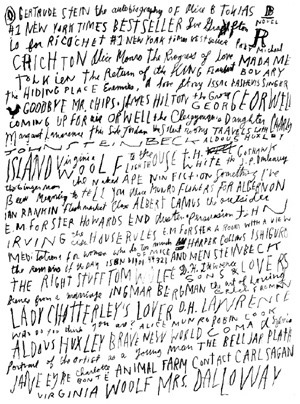 I’m an inveterate list-maker — all the books I’ve read since 1981, all the bike rides I’ve ever taken, the steps to the ballet combinations from my weekly class — not to mention the dreaded and never ending to-do list. I’m an inveterate list-maker — all the books I’ve read since 1981, all the bike rides I’ve ever taken, the steps to the ballet combinations from my weekly class — not to mention the dreaded and never ending to-do list. |
 I’m an inveterate list-maker — all the books I’ve read since 1981, all the bike rides I’ve ever taken, the steps to the ballet combinations from my weekly class — not to mention the dreaded and never ending to-do list. I’m an inveterate list-maker — all the books I’ve read since 1981, all the bike rides I’ve ever taken, the steps to the ballet combinations from my weekly class — not to mention the dreaded and never ending to-do list. |
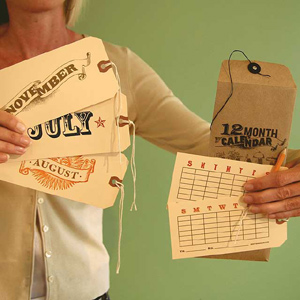 For the past several years, I’ve designed a calendar for an annual year-end show of calendars at the San Francisco Center for the Book, sponsored by the Pacific Center for the Book Arts. Over time my designs have gotten more involved, and my calendar this year was a big production for me. I’m excited to see what the other members have created for the show. But in the meantime, Holly at Decor8 has posted a really nice guide of handmade calendars. Click on the picture to see them all (the picture shows a perpetual calendar from CP Swap Meat.)
For the past several years, I’ve designed a calendar for an annual year-end show of calendars at the San Francisco Center for the Book, sponsored by the Pacific Center for the Book Arts. Over time my designs have gotten more involved, and my calendar this year was a big production for me. I’m excited to see what the other members have created for the show. But in the meantime, Holly at Decor8 has posted a really nice guide of handmade calendars. Click on the picture to see them all (the picture shows a perpetual calendar from CP Swap Meat.)
![]() You can see all my posts about calendar making here.
You can see all my posts about calendar making here.
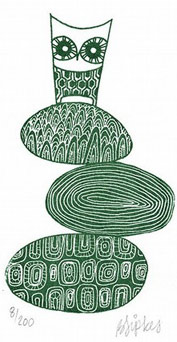 One of the nicest parts of the Book Jam last Saturday was chatting during the slow times with the book artists’ at the table adjacent to mine, Kate Godfrey and Nikki Thompson. Nikki produces books using hand-set type on a letterpress as well as with her Japanese-made Gocco printer (a small screen printing system). Throughout the day, I over-heard Nikki describing her Gocco and how it works to visitors and then end with “but the machines aren’t imported any more and it’s hard to get supplies”.
One of the nicest parts of the Book Jam last Saturday was chatting during the slow times with the book artists’ at the table adjacent to mine, Kate Godfrey and Nikki Thompson. Nikki produces books using hand-set type on a letterpress as well as with her Japanese-made Gocco printer (a small screen printing system). Throughout the day, I over-heard Nikki describing her Gocco and how it works to visitors and then end with “but the machines aren’t imported any more and it’s hard to get supplies”.
![]() My knowledge about Gocco printing is pretty limited — it’s popular on Etsy to make cards, prints, housewares and t-shirts. And in one of the first issues of Ampersand that I edited, Nicholas Yeager explains how to use a Gocco printer to etch images in metal. (The owl to the right is a Gocco produced print by Bernadette Sipkes that’s hanging in my house.)
My knowledge about Gocco printing is pretty limited — it’s popular on Etsy to make cards, prints, housewares and t-shirts. And in one of the first issues of Ampersand that I edited, Nicholas Yeager explains how to use a Gocco printer to etch images in metal. (The owl to the right is a Gocco produced print by Bernadette Sipkes that’s hanging in my house.)
![]() So imagine my surprise on Sunday when I opened the New York Times Sunday Magazine (of all things!) to find an article entitled The Cult of Gocco: How the end of a product turned into a publicity event — and maybe, a new beginning. It seems that an artist named Jill Bliss started the website SaveGocco.com to do just that — create enough publicity that would inspire the Japanese Gocco manufacturer Riso to make and import the machines again with a letter writing campaign.
So imagine my surprise on Sunday when I opened the New York Times Sunday Magazine (of all things!) to find an article entitled The Cult of Gocco: How the end of a product turned into a publicity event — and maybe, a new beginning. It seems that an artist named Jill Bliss started the website SaveGocco.com to do just that — create enough publicity that would inspire the Japanese Gocco manufacturer Riso to make and import the machines again with a letter writing campaign.
![]() From poking around on the web a bit, it looks like they’ve had some success, as more and more stores carry both the machines and supplies. Here in San Francisco, Arch is now importing and selling machines & supplies. Online Paper Source and Wet Paint Art sell machines. The Japanese-based Etsy sellers Print Addict Japan, Felt Cafe and good-ness will ship supplies and machines to the US. Nikki says she buys her supplies from Welch Products. And there are yet more dealers here.
From poking around on the web a bit, it looks like they’ve had some success, as more and more stores carry both the machines and supplies. Here in San Francisco, Arch is now importing and selling machines & supplies. Online Paper Source and Wet Paint Art sell machines. The Japanese-based Etsy sellers Print Addict Japan, Felt Cafe and good-ness will ship supplies and machines to the US. Nikki says she buys her supplies from Welch Products. And there are yet more dealers here.
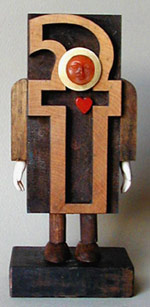 This past Saturday at the Books Arts Jam Fair I saw Elaine Benjamin of Blue Chair Press. We got to be friends several years ago when we both had tables at a book fair in Seattle. Elaine contacted me about sharing a hotel room because our press names were so similiar! I’m really glad she did, because as a bonus to saving money on my hotel room, we spent a relaxing day before the bustle and stress of the fair weekend exploring a bit of Seattle.
This past Saturday at the Books Arts Jam Fair I saw Elaine Benjamin of Blue Chair Press. We got to be friends several years ago when we both had tables at a book fair in Seattle. Elaine contacted me about sharing a hotel room because our press names were so similiar! I’m really glad she did, because as a bonus to saving money on my hotel room, we spent a relaxing day before the bustle and stress of the fair weekend exploring a bit of Seattle.
![]() Elaine makes books but also uses words and type in her prints (like the dictionary page below) and in her Dada Dolls. She writes a story about each doll and attaches it to the back. I especially like the ones that incorporate wooden type.
Elaine makes books but also uses words and type in her prints (like the dictionary page below) and in her Dada Dolls. She writes a story about each doll and attaches it to the back. I especially like the ones that incorporate wooden type.
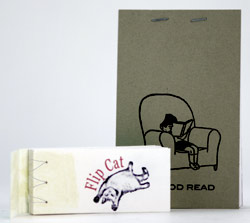 This Saturday, I’ll have a table at the Book Arts Jam at Foothill College in Los Altos Hills, CA. So this week I’ve been busy making up books to sell, especially my 2 flip books, A Good Read and Leila, Just Another Day. This Saturday, I’ll have a table at the Book Arts Jam at Foothill College in Los Altos Hills, CA. So this week I’ve been busy making up books to sell, especially my 2 flip books, A Good Read and Leila, Just Another Day.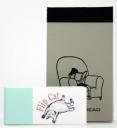 |
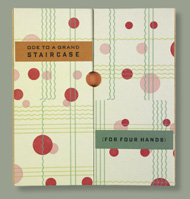 Most books are about the words inside — “Pride and Prejudice” is good whether in a used and worn paperback or a finely bound volume. Not so for most artists’ books. Not only do you need to “read” them in the conventional sense of reading the words but almost universally they can’t be appreciated or understood without manipulating the structure in some way. The paper, the binding, the overall construction contribute to the words and images.
Most books are about the words inside — “Pride and Prejudice” is good whether in a used and worn paperback or a finely bound volume. Not so for most artists’ books. Not only do you need to “read” them in the conventional sense of reading the words but almost universally they can’t be appreciated or understood without manipulating the structure in some way. The paper, the binding, the overall construction contribute to the words and images.
![]() So exhibitions of artists’ books can be difficult to mount effectively. The books are often fragile and from very small editions so can’t be handled or replaced. At most you can show one spread, the covers and the spine.
So exhibitions of artists’ books can be difficult to mount effectively. The books are often fragile and from very small editions so can’t be handled or replaced. At most you can show one spread, the covers and the spine.
![]() Enter the video — a short movie can show off a book very well. Here are two I know about; if you know of any other good online displays of artists’ books, let me know.
Enter the video — a short movie can show off a book very well. Here are two I know about; if you know of any other good online displays of artists’ books, let me know.